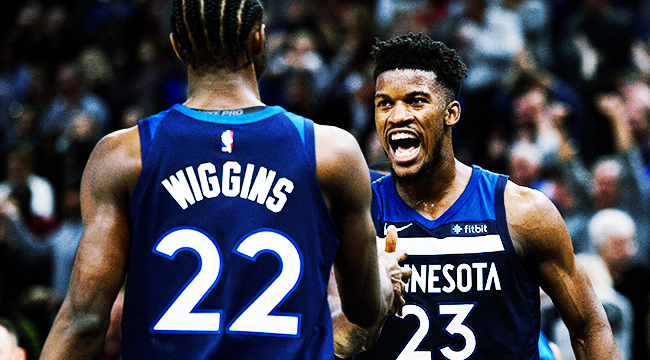
Already one of the best offensive teams in the NBA, the Timberwolves bolstered their young core of Karl-Anthony Towns and Andrew Wiggins this offseason by trading for Jimmy Butler and signing Jeff Teague. While none of them are knockdown 3-point shooters, they’re each capable of creating their own shot in a variety of ways, which helps Minnesota cover up a lot of its shortcomings on offense.
Butler and Wiggins in particular give the Timberwolves an interesting one-two punch in the backcourt. They are incredibly similar players on paper, both in terms of how they score their points and where they like to shoot from. They’re also two of the better athletes at their position, giving Timberwolves head coach Tom Thibodeau plenty of options when it comes to how he uses them in the halfcourt.
This is one of the more creative ways Thibodeau maximizes their versatility as scorers, as well as their athleticism, to create easy baskets.
The play begins with Teague making a pass to Wiggins on the left wing. As soon as he gets rid of the ball, Teague moves towards the middle of the court to set a screen for Butler, who is stationed next to Taj Gibson and Towns on the weakside. Butler then uses Teague’s screen to cut from the right wing to the left block for what appears to be a post-up in front of Wiggins.
Rather than passing the ball to Butler — not a bad option considering the former Bulls star averaged 1.07 points per post-up possession last season — Wiggins gives it to Towns at the top of the perimeter. With the ball no longer in his hands, Wiggins makes a cut towards the basket, utilizing a back screen from Butler along the way to create some separation from his defender. Towns passes the ball to Teague on the right wing while that’s going on.
The play isn’t designed for Wiggins to score in this particular situation, but it’s important that he baits the defense into thinking it could be for him. Obviously a pass from Teague or Towns to Wiggins is an option if his defender is trailing the play. It’s what happens on this possession.
More often than not, though, Wiggins isn’t open. If Wiggins is successful in drawing the attention away from Butler and the ball, it sets the wheels in motion for the next part.
With Teague on the opposite side of the floor, Towns in the middle of the floor and Wiggins running towards Gibson on the right block for a possible pindown, the left side of the floor is completely clear. To take advantage of that spacing, Butler fools his defender into thinking he’s going to run off of a down screen from Towns for a jump shot or pick-and-roll by taking a step towards the perimeter. When his defender begins to follow him, Butler darts in the other direction for an alley-oop.
Butler’s timing is important. If he takes off too soon, he faces the possibility of running into Wiggins and his defender underneath the basket. But if he takes off too late, the help defense will have time to figure out what they’re doing.
Take off at just the right time, though, and there’s nobody in the paint who can stop him from getting a layup or dunk.
The same goes for Wiggins. It doesn’t necessarily have to be a hard cut to the basket, but he has to do just enough to prevent his defender from helping off of him. The fact that he’s moving towards the strong side with Gibson in position to set a screen on him keeps the defense engaged.
Then there is Towns, who is making 36.8 percent of his catch-and-shoot 3-pointers this season. His ability to space the floor out to the perimeter as a power forward or center draws his man away from the basket, paving the way for the alley-oop. If the Timberwolves replaced Towns with Gibson, for example, it wouldn’t be nearly as effective because his defender wouldn’t have to guard him as close.
While three of the positions aren’t interchangeable, two of them are. As the more explosive athlete, Wiggins can easily take Butler’s spot as the initial screener and diver. That leaves Butler as the most likely candidate to replace Wiggins in the above possession, but they can still run the play with Jamal Crawford when Butler goes to the bench.
What matter is they have someone who the defense respects as a scorer, whether it’s as a cutter or shooter.
The Timberwolves ran the play last season with Wiggins as the scorer and Ricky Rubio as the passer. The difference is Butler is a far more dangerous scoring threat than Brandon Rush and Shabazz Muhammad, both of whom the players the Timberwolves used as the cutter. The defense is therefore more likely to fall for his cut when he’s used as a decoy, which opens up the lane for Wiggins.
Plus, being able to switch Wiggins with Butler isn’t something they could do as easily Rush and Muhammad, making it slightly harder for the defense to game plan against. It’s one of many examples of how Butler makes the Timberwolves a more dynamic offensive team.






